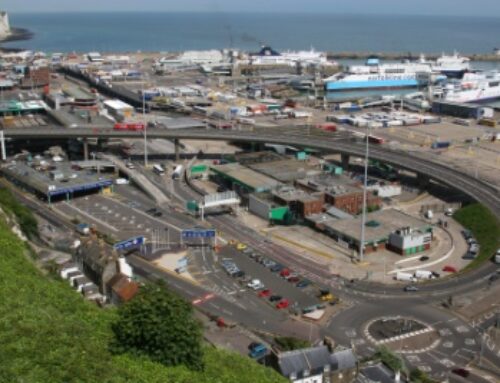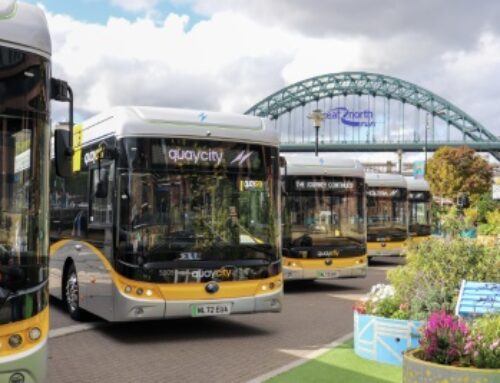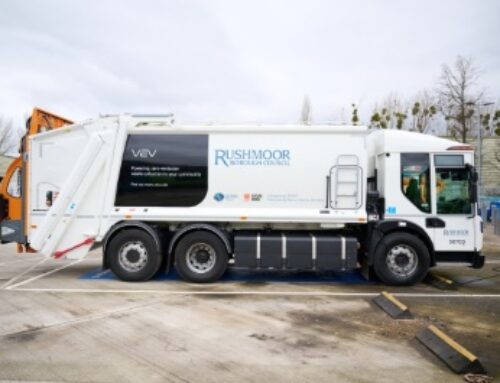UK falls in line for platooning
 Among the more eye-catching measures announced in George Osborne’s Budget last month was a commitment to “establish the UK as a global centre for excellence in connected and autonomous vehicles.”
Among the more eye-catching measures announced in George Osborne’s Budget last month was a commitment to “establish the UK as a global centre for excellence in connected and autonomous vehicles.”
The government has promised to consult later this year on “sweeping away regulatory barriers” to enable autonomous vehicles to operate on major roads in England.
Its plan also entails the establishment of a £15m so-called “connected corridor” from London to Dover, which would enable wireless communication between vehicles and infrastructure, with the potential for vehicle-to-vehicle connectivity.
In addition to a commitment to conduct trials of driverless cars by 2017, the government also promised to “carry out trials of truck platooning on the strategic road network”.
The technology to allow groups of trucks to travel in much closer succession than would be safe in normal conditions, communicating wirelessly to regulate proximity, already exists – with most of the major vehicle manufacturers working on platooning in a bid to reduce fuel consumption via drag reduction, improve safety through eliminating driver reaction time, and better utilise road capacity.
DAF, Daimler, Iveco, MAN, Scania and Volvo are all taking part in the European Truck Platooning Challenge, a project spearheaded by the Netherlands as part of its EU presidency this year.
A key stated aim of the challenge, which saw convoys of platooning trucks from all the manufacturers descend on Rotterdam as Transport Operator went to press this month, is to highlight the changes that would be required in EU transport legislation in order to allow platooning to take place on an everyday basis.
For example, Volvo Group is bringing three FH trucks and trailers from Gothenburg in Sweden to Rotterdam, via Denmark, Germany and Belgium – using wireless connectivity to allow them to synchronise speeds and brake simultaneously, thereby allowing them to travel with just a one-second gap between the vehicles.
Anders Kellström, project manager for Volvo, said: “We believe that platooning offers major advantages, mainly for our customers, but also for society in general in the form of fuel savings, reduced emissions and enhanced transportation efficiency.
“Together with the rest of society, the transportation industry needs to tackle such challenges as the harmonisation of legislation, and in so doing promote the introduction of platooning in Europe.”
DAF Trucks’ EcoTwin project, meanwhile, developed by a consortium which also includes TNO, NXP and Ricardo, is aiming for a distance between the vehicles of 0.5 seconds – around 10 metres at 50mph.
“It goes without saying that there is still a lot of continued development required before we can introduce platooning as a new technology on the market,” said Ron Borsboom, DAF management board member with responsibility for product development.
“This is definitely not a process that will be complete before 2020. There is still a great deal that has to be sorted out in terms of legislation, liability and acceptance…
“This demonstration should pave the way for truck manufacturers to be allowed to carry out further testing of the technology on public roads in order to acquire even more experience. It is now up to politicians to make this possible.”
But the Road Haulage Association (RHA) has responded cautiously to Mr Osborne’s announcement regarding UK trials, adding that it would follow them with “keen interest”.
“At the outset, it is important to note that these trucks will not be ‘driverless’,” said Richard Burnett, chief executive of the RHA. “Each cab will be manned. As far as we are concerned, this is an issue where the devil lies in the detail.”
He explained: “When platooning trials eventually begin, they will be carried out ‘off road’ and will only be trialled on the motorway network when proven off-road.
“On the plus side, this is a concept that certainly has benefits in terms of fuel saving; particularly in those countries that have long stretches of roads without junctions – unlike the UK motorway network.
“Today’s UK haulage industry is increasingly IT-led. However, are UK roads and, more importantly, other road users ready for it?”
Burnett added: “In addition to the concerns of the motorist, is platooning practical for the haulier? Does it make operational sense and, critically, will it be safe practice on UK roads with so many junctions?”
A further safety issue was raised by John Smith, principal solution architect at cloud-based software solutions provider Veracode.
“The UK government’s decision to invest in leading-edge technologies, such as new driverless lorries, is commendable as this technology is capable of speeding up deliveries and cutting congestion,” he said.
“However, cybersecurity factors must be brought to the forefront of policy agendas from the outset. Government bodies and manufacturers need to prioritise security across systems that impact safety – such as software and applications downloaded to the lorries.
“Today, vulnerable software is one of the most significant challenges faced by the automotive industry. Findings from a recent IDC report indicated that there could be a lag of up to three years before car security systems are protected from hackers.
“With over 200 million lines of code in today’s connected car, not to mention smartphone apps linked to the car, we must ensure they are developed with security at the heart of the strategy, rather than as an afterthought.”
Axa UK, which is involved in three driverless car projects funded by the government, welcomed the truck platooning announcement.
“It is great to see the government accelerate its plans regarding autonomous vehicles and haulage specifically and acknowledging its importance to the future of the UK economy and society as a whole,” said technical director David Williams.
“We have calculated that driverless haulage vehicles could deliver nearly £34 billion in savings to companies using haulage, in the 10 years after the technology has been adopted.
“Trialling truck platooning on the strategic road network is the first step to full autonomous haulage on UK roads. This will lead to lower costs and critically, a significant reduction in road accidents. 6,000 reportable road accidents were caused by HGVs in 2013 alone, and driverless technology has the potential to all but eradicate human error.”
The Transport Research Laboratory’s (TRL) academy director Professor Nick Reed commented that the UK trials were: “a logical next step following TRL’s work alongside Ricardo for the Department of Transport (DfT) on the feasibility of operating commercial vehicle platoons.”
Claiming the trials were “vital” to ensure UK haulage remained “competitive globally,” he added: “The technology needs to be proven to be safe before it moves to on-road trials, and thus gradually builds in complexity, to establish the scale of the benefits achievable in the context of real-world driving.
“The precise scope of trials remains to be defined, but we envisage that all vehicles participating in trials will have fully trained and qualified drivers at the controls at all times.”
“Secondly, the haulage industry must be closely involved in the trials to examine the practical requirements for platooning in a commercial and operational environment,” he added.
“Within this, the needs of drivers must be prioritised. The further training required for drivers of the convoy’s lead and following trucks is important to ensure the safe operation of the platoon, and particular attention must be paid to the in-vehicle information systems that control platoon formation.”











